Learn from my mistakes: The right way to paint latex over oil
Lesson learned: do not paint latex paint directly over oil-based paint! Learn how to fix peeling latex paint and the steps to safely paint latex over oil.
When we moved into this house several years ago, the walls were painted dingy pastel colors and all of the trim was painted to match the walls.
I immediately got to work painting the walls in a fresher color palette and painting the trim a nice crisp white.
Unfortunately, I made a huge mistake.
I skipped a vital step. I didn’t stop to check what kind of paint the trim had been painted with previously – I just got myself a nice can of semi-gloss white paint and blissfully painted away.
I had no idea that the gold standard used to be painting doors and trim with oil-based paint.
And honestly, even if I had known, I wouldn’t have realized that you can’t just paint latex paint right on top of oil-based paint.
Latex paint simply isn’t going to stick to oil-based paint.
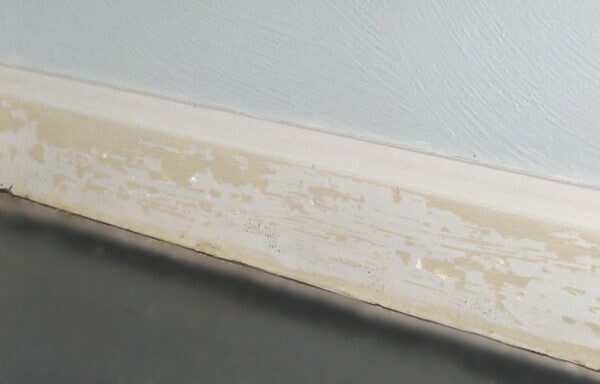
I started to realize something was wrong within a matter of days – the fresh white paint I added to all of our trim and doors could be scratched right off with a simple touch.
And within months, it started peeling off like crazy. So frustrating!
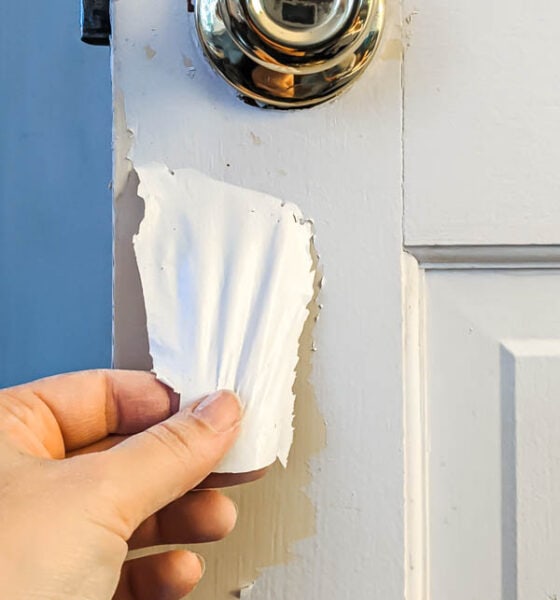
It’s been several years since that maddening mistake and I’ve learned a ton about the dos and don’ts of oil-based paint in that time.
Now I’m sharing it all with you in the hopes I can spare someone else the headache I caused myself.
Let’s start with the basics of correctly painting over oil-based paint and then I’ll share how I solved my problem for anyone else who may have painted with latex paint over oil-based paint with disastrous results.

This post contains affiliate links which means if you make a purchase after clicking a link I will earn a small commission but it won’t cost you a penny more. Click here to see my full disclosure policy
How can you know if something is painted with oil-based paint?
A lot of times when we have an older home, we have no idea what type of paint was used.
Almost all trim in older homes is painted using oil-based paints and a good portion of the trim in newer homes as well.
Before you repaint any woodwork, there is an easy test you can do to determine what type of paint was used in your home.
Pour a little bit of nail polish remover (with acetone) or rubbing alcohol onto a rag.
Rub it onto the painted surface that you want to test.
If some of the paint rubs off, it is latex paint. If no paint rubs off, it is oil-based paint.
Be sure to use a dark rag for light paint and vice versa so it will be easy to tell if the paint is rubbing off.
How to paint with latex paint over oil
As I’ve already mentioned, you definitely should not paint latex paint directly onto oil-based paint.
It might look ok for a minute, but it definitely will not last. Latex paint will not bond to oil-based paint.
They’re like oil and water. (Haha, get it?)
Thankfully, there is a way to paint latex paint over oil-based paint. So if you discover that parts of your home were painted with oil-based paint, you aren’t stuck using oil-based paint forever.
The crucial step that I missed is that you must first use an oil-based primer.
Once your primer has dried, you can paint it with either oil-based paint or latex paint.
Yes, I know it is confusing. You can never paint latex paint directly over oil-based paint, but latex paint over oil-based primer works perfectly.
How to solve peeling latex paint over oil-based paint
This brings me back to my own badly peeling latex paint. I had already painted basically all of the trim in our home with latex paint and no primer.
So what could I do to fix it now?
I started doing research on all of the potential solutions and none of them sounded very fun.
These are the solutions I found:
- Replace all of the trim.
- Strip off the latex paint using a chemical stripper and then prime with an oil-based primer and repaint.
- Sand off the latex paint and then prime with an oil-based primer and repaint.
Well, replacing all of the trim was out for sure. That would take way too much time and money.
I also wasn’t a huge fan of the second option. I have used chemical strippers to strip furniture before and they work well.
But it would be very difficult and messy to strip all of the trim without removing it first.
And again, removing all of the trim would be a huge undertaking.
The Solution I Used
I chose option three – the sanding option.
*Important Safety Note* If your home was built before 1978, there is a chance it may have been painted using lead-based paint. You should never scrape or sand lead paint, because it releases lead dust into the air and inhaling lead dust is very dangerous.
If your home was built before that time, you can buy an inexpensive lead paint test to check for the presence of lead. These are very easy to use, only cost a few dollars, and can save your family from serious future health problems so it is worth your time.
I started by using a paint scraper to gently scrape off any paint that was actively peeling off.
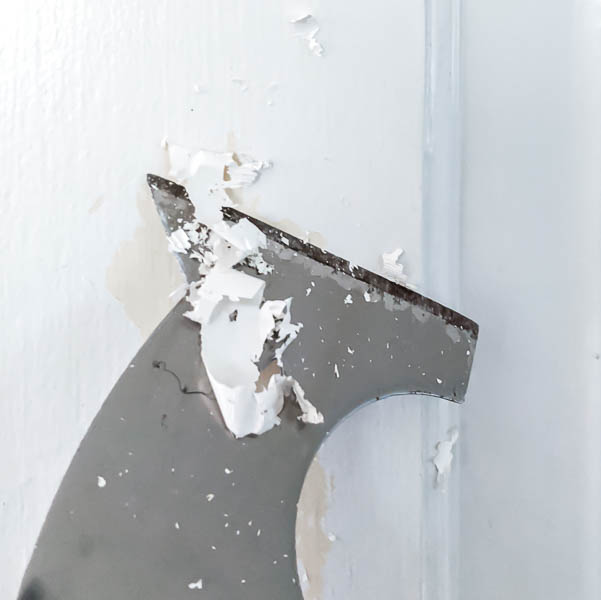
Then I used a palm sander to sand the flat areas of the doors and baseboards and I hand-sanded the more detailed areas.
I did not sand off every last bit of paint. I found mixed advice about this: some people said that you must remove every speck of latex paint; others said that you could just remove the loose paint.
I had a ton of area to sand and repaint – most of the baseboards and doors in our entire home.
So I chose to sand all of the loose paint really well, making sure that absolutely anything that was loose, peeling, or scratched was removed.
Once all of the loose paint was removed, I primed everything with an oil-based primer. (This is my favorite oil-based primer that I have come to trust implicitly.)
When the primer was fully dried, I painted once again with my bright white latex paint.
And this time it went on so much better. I could immediately tell that it was adhering differently this time around.
And once the paint had fully dried and cured, it didn’t scrape off at the slightest scratch.
It’s now been a few years since I sanded and repainted my trim and it has held up beautifully.
There have been a few scratches and dings here and there over the years, but no more than you would expect from any trim in an active home with three little boys.
I hope this information has helped save you from making the same mistakes.
And if it’s already too late for that, helped get you started fixing the problem.
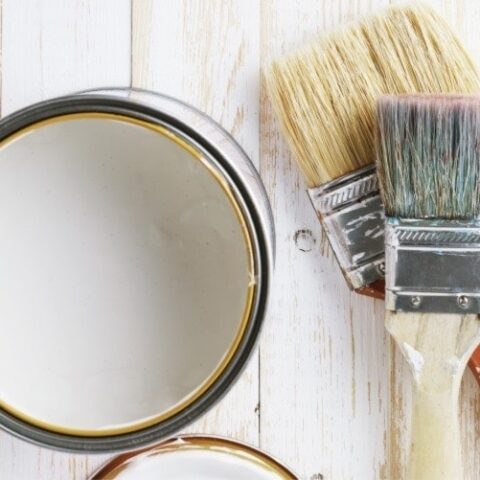
How to Paint over Oil-Based Paint
Learn the right way to paint with latex paint over oil-based paint and save yourself a lot of future frustration!
Materials
- All purpose cleaner
- Oil-based primer
- Latex paint
- Mineral Spirits
Tools
- 2 paintbrushes
- painter's tape (optional)
Instructions
- Start by cleaning the surface you will be painting. Simple dish soap and water works well for this.
- Use painter's tape if needed to protect adjoining surfaces.
- Prime the surface with a good oil-based primer.
- Allow the primer to fully dry.
- Paint the surface with the latex paint of your choice.
- Allow the paint to dry and apply additional coats of paint as needed.
Notes
You will need to use Mineral Spirits to clean the paintbrush that you used for the oil-based primer. The paintbrush used with latex paint can be cleaned with water.
Recommended Products
As an Amazon Associate and member of other affiliate programs, I earn from qualifying purchases.
I’d love for you to share this post on Pinterest.
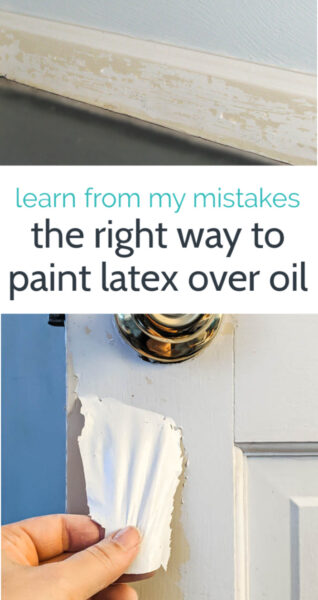
Here are a few more posts I think you’ll find helpful:
Everything You Need to Know about Primer
Caulk or Wood Filler: Choose the Right One for Every Project
The Best Paintbrushes for a Perfectly Smooth Paint Finish




we have wood trim and i have been working on painting it- i sanded it lightly and the primer adhered well to all but the quarter round at the bottom- UGH. if it gets hit it gets nicked! so frustrating! it is only done in a couple rooms, but the rest will get the quarter round treated with deglosser i think first- what a pain! i feel ya!
we have wood trim and i have been working on painting it- i sanded it lightly and the primer adhered well to all but the quarter round at the bottom- UGH. if it gets hit it gets nicked! so frustrating! it is only done in a couple rooms, but the rest will get the quarter round treated with deglosser i think first- what a pain! i feel ya!
Um… that’s probably what happened in our house. We rent, but when we moved in all of our trims & doors were pretty white. They have been peeling steadily since then to reveal a tanish-yellowish layer beneath the white. Lovely.
Oh so sorry that happened to you. It is very sweet of you to pass this info along to us. I reallly appreciate you doing that. Good luck with your sanding.
Oh dear….I did the same thing many years ago with a door in our very first house. It took me awhile to figure out why the new paint was peeling off the door. Not the kind of thing you repeat! None of us really need ‘make work’ projects!
Yes…been there…done that. We live in an old, old farmhouse and I found that I always have to prime everything FIRST. I’ve found my best friend is a little palm sander…they are GREAT and not that big of an expense…will help you make the sanding job a LOT easier! I always cut several pieces of sandpaper to fit the Palm sander so they are ready when I need a new sheet. It’ll go quicker than you realize once you just start. I counted it as a good learning experience!
Hello! Just want to say thank you for this interesting article! =) Peace, Joy.
We just recently bought a house that was built in 1969. Its in great shape for a 43 year old home. Then I noticed everything painted with this beautiful white color (trim, doors, windows) is peeling!! It is so irritating. I started looking up ways to fix this and now I’m starting to wonder if its cheaper to just replace everything. This is 1800 sq house with white trim peeling in every direction. I don’t even know what I will do next.. URG.
That is awful!! We just painted the interior our new house. Everything is peeling, when knicked, except the walls. We have spent weeks and tons of money all to be wasted. I had no idea about the oil paint and latex paint. I think every paint salesperson on the planet should mention this to customers!!
I feel for you. Good luck!
Same thing is happening in my house…..do you need to prime with an oil-based primer or can you use a latex-based primer? I usually sand that oil based layer and then wash, prime and paint….but both primer and paint are latex. Is that okay??
Oh no – sorry you have the same problem. It is really better to use an oil-based primer. That way you can avoid this happening again in the future. I sanded off all of the loose flaking paint and then primed with oil based primer followed by latex paint. That method works great.
Thanks for sharing. I’m a little confused though. If you’re using an oil-based primer and painting with a latex-based paint, how will this prevent the same thing from happening again? You’re putting latex over oil again. We are dealing with the peeling of latex paint over oil paint and not sure if a primer was used in between. Don’t want to make the same mistake the previous owners did!
It is very confusing. I don’t know the mechanics of why, but either oil or latex paint can be painted over oil primer. I often use latex paint over oil primer (and so do others – I didn’t make this up, I did research!) And oil primer can of course be used over oil paint. So the oil primer acts as a buffer between the two paints. If you are concerned, you can double check on your oil primer can that it says it can be top coated with water or oil-based paints.
I’m so glad to come across this! We PAID professionals to paint our Den that had dark woodwork everywhere, including wainscoting and built ins, and they made the same mistake. I started doing our eat in kitchen the same way when one of the painters stopped and told me he’d realized the mistake.
I had just primed all the crown molding with a latex primer. My question is, how well do I have to sand it off? Is it ok for some of it to still be there? Some of the molding has a lot of curves so it’s hard to get everything (and taking forever!) I just want to make sure the oil based will stick, I don’t want to do this again. :)
Leaving the den for now and crossing our fingers it wears slowly. The contractor of course won’t return our calls. :)
Wow, that is horrible! When you pay someone for a job, you expect them to know what they are doing. And definitely to fix any mistakes they make.
I sanded my trim, re-primed with oil based primer, and then repainted. When I sanded off the latex paint, I did not sand off every speck. I sanded everything but only made sure to completely remove anything loose and flaky. I cannot guarantee that my method will work forever – but I redid my trim a year and a half ago with zero problems so far.
I just had a professional come in and paint the majority of the trim and doors in my entire house. (He also did the walls). I paid him in full, had brand new carpet installed…. Then, the abrasive backing on the carpet unraveled a terribly stressful situation for a 6 month pregnant woman who has spent all of her money- the “professional” painted latex paint over oil paint on every piece of trim and door/closet door in the majority of the house! It’s peeling EVERYWHERE. I have taken the day off today to remove the latex paint and sand the original down but it is extremely overwhelming!!
Oh Meghan, that is terrible! Sometimes professionals really aren’t very professional at all! Have you tried contacting him to fix it? Wish I could come help you – no pregnant woman should have to deal with that mess.
Your floor totally rocks! Awesome job! We are in the process of starting a project very similar to yours.thank you for sealing our thoughts.
Thanks! Good luck on your project!
I have trim that has latex on it and I want to go oil, is that okay?
If you use an oil based primer over the latex paint followed by oil paint, you’ll be fine.
Thanks for the test tip. It was useful. Turns out it’s latex. Thank God!
So glad it helped! And happy for you it is latex!
I am a self-employed carpentry contractor with 30+ years experience. I did not know this about oil and latex paints. Shame is, this just happened to a friend of mine, She paid professional painters to repaint her hallway and master bedroom, when they were done it looked beautiful. then the curtain man came, he said I’m sorry but this trim paint is coming off! all you had to do was touch it and came off! My friend knew for certain they had primered everything! But apparently with latex… Now, the furniture has to all be moved out again and the whole process is redone. I’m so glad I wasn’t involved, I feel awful nonetheless. This woman thought she was doing everything right, with good people. I haven’t heard whether the painter will make good on the work or not, I hope so.
Oh no! That is terrible! It’s bad enough to do it in your own house, but so much worse for a professional. I certainly hope the painters make good on it since it was their fault, even if it is an easy mistake to make!
I don’t knoe what to do in my daughters room. the woman who lived here before us used to take any paint she could find and mix them together and use it..so our walls were all VERY strange colors. When I painted my daughters room last, over a dark electric blue, these large bubbles started forming and now ALL her walls are bubbling and peeling. Large holes…I’m so upset. Where do I start? It’s all the drywall :(
Oh no, that is horrible! Sadly, you are definitely going to have to peel off and remove as much of the new paint as possible. You can test to see if the paint underneath was oil based paint using denatured alcohol. It would be really strange to have oil-based paint on drywall but I guess people do crazy things sometimes. If it is oil-based, you can prime the walls with an oil-based primer, let is dry thoroughly, and then paint them with regular latex paint. It could also be that the walls had something else strange on them. If the paint wasn’t oil based, you can clean them really well with something like TSP. There may have been some kind of grease or other chemical on the walls or in the paint. Let the walls dry from the cleaner and then paint on a test patch and see how it does. Good luck!
I moved into a house where the previous owner had painted over oil with latex and I needed to sand off all the latex and scuff the old oil paint underneath. My dilemma then was whether to paint with oil or latex. I went with oil and have never regretted it. It holds up much better than latex and has a much fresher look for longer as well. My advice for nearly all situations is to prime with BIN 123 primer after scrubbing with a TSP (tri-sodium phosphate) solution. If there is any mold add bleach to the solution. If there is a gloss remaining on the old paint either scuff it with medium to fine sand paper or use deglosser. Scrubbing with the green scotch pads also works well. Don’t fear oil based paint as it is good for the wood and looks great longer. Just learn how to clean your brushes correctly and clean up immediately with paint thinner or turpentine. Ventilate as recommended when using any solvents!
Great tips. I agree – oil gets such a bad reputation but there is a reason it was used for so long!
My husband just bought what he thought was oil base trim paint, I had already painted the trim on three big windows. The paint has already dried and we realized it was latex. What can I do to undo, since all my trim is oil based. Obviously it hasn’t had time to peal, but need a fix to undo.
Oh man, that stinks. I would sand off any paint that comes off easily and then prime with oil-based primer followed by oil-based paint. Good luck!
What is the oil base primer name and brand you used please ?
I love and use the Zinsser Cover Stain oil-based primer.
I too have made this mistake…baseboards and doors. Ugh! I’m a little confused on the process. Not all paint is peeling or scratching yet. So After I sand the peeling/scratched paint off is it necessary I sand the rest of the latex paint before using the oil based primer?
Oh no, I’m sorry you are dealing with this too! If you want to be absolutely, 100% sure you everything is completely fixed, you can sand off all of the latex paint. But that is a ton of work. For my own baseboards and doors, I only sanded off the paint that was loose or peeling. I did go over everything with my sander to make sure I caught everything loose, but if it was firmly attached, I left it in place. Then I cleaned it off, primed with oil-based primer, and repainted. It has been a few years and it is holding up well with no further peeling. Good luck!
Obviously, I’m having this problem since I found this post. What kind of palm sander do you use? I have decision paralysis when I have too many choices.
I have used a few different ones. Currently I have this one and really like it – https://amzn.to/37jg5uk
We just recently bought a house and painted the cabinets. We did not realize it was an oil based paint on the cabinets before and started noticing while painting that it was chipping some. Some areas have not chipped at all because we just painted them. Do you think we could just chip off the few spots, paint over the latex paint with an oil based primer, and then paint the cabinets with latex paint?
Thanks!
Yes, that is what I would do. Any areas that are loose at all, I would sand well. And I would feel carefully to make sure not to miss any loose areas because you definitely don’t want to paint it again only to have it fail down the road. But if you sand down anything loose and then use an oil-based primer and latex paint, you should be good to go. This is what I did to fix all of our interior doors where I painted latex over oil and they have held up great.
Thank you, I am dealing with this exact issue now!!
Lisa
I’m sorry – it’s the worst!
PLEASE point out to your audience that if they are sanding down old paint, it is essential to TEST FOR LEAD PAINT before sanding or removal. There is a whole generation of kids growing up in gorgeous older houses that are being renovated and restored who are being exposed to unsafe levels of lead dust. Lead poisoning today looks nothing like the old cliched PSAs featuring city kids in the 1960s eating paint chips. These days it is an upper middle class kid in a gorgeous older home getting exposed to lead dust created by renovation and basic wear and tear of older lead-based paints. Paint from the 1930s contained as much as 50% lead. Lead was not phased out from house paint until 1978. (It is STILL used in marine paint and bathroom porcelain fixtures). Kids under 5 are especially susceptible to lead poisoning. Lead poisoning can cause IQ deficits, behavioral problems, and a whole host of other negative health outcomes which are not reversible. Please do not encourage sanding without first testing. Thanks!
This is a very important point. You are absolutely right, lead poisoning is a serious issue and testing for it is not difficult. Thanks for pointing out this omission!
I wish the previous owner of my house had read this article. I am now left with 2300 ft.² worth of walls and trim where latex was placed over oil paint. I hired a painter but can’t afford to have him come in and remove it so I will spend the remainder of this calendar year on a ladder with a scrapper in my hand!
I discovered a new type of paint a few years ago when I was going to paint my kitchen. It is a hybrid between oil and latex. The oil part is the part that adheres to wood and the latex part is that you can wash your brushes and rollers with water. I only use the one by Sherwin Williams Emerald Urethane Trim Enamel, but Valspar also has one called furniture and cabinets and all my furniture has been painted with that. I moved into an older home and painted the living, dining and bathroom trim with this type of paint two years ago and it has held pretty well. I am also going to paint the bathrooms which were painted with oil paint with this product.
This is a great tip! I haven’t used this paint yet personally, but I’m planning to try it when I paint my kitchen cabinets.